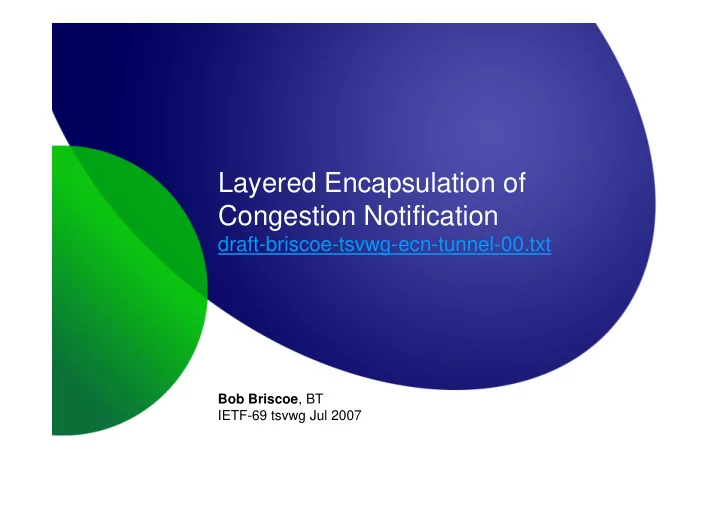

Layered Encapsulation of Congestion Notification draft-briscoe-tsvwg-ecn-tunnel-00.txt Bob Briscoe , BT IETF-69 tsvwg Jul 2007
initial draft • Layered Encapsulation of Congestion Notification • initial draft: draft-briscoe-tsvwg-ecn-tunnel-00.txt • intended status: standards track • immediate intent: move to WG item discuss widening scope • exec summary • propose to update RFC3168 ECN tunnel behaviour for all IP in IP – only wire protocol processing, not marking or response algorithms • to bring into line with new RFC4301 IPsec ECN behaviour • defines default tunnel processing of ECN field for all Diffserv PHBs – but also gives guidance on alternatives for specific PHBs (e.g. PCN) and for specific link encapsulations (e.g. MPLS) 2
one main change to RFC3168 ECN E E DS DS C C N N E ‘I’ E E E E DS C DS C DS C DS C N N N N encapsulation at tunnel ingress decapsulation at tunnel egress ‘I’ incoming outgoing outer header RFC3168 RFC3168 RFC430 proposed proposed ECN limited ECN full 1 IPsec all IP in IP all IP in IP functionality functionality compatibility mode normal mode Not-ECT Not-ECT Not-ECT Not-ECT Not-ECT Not-ECT ECT(0) Not-ECT ECT(0) ECT(0) Not-ECT ECT(0) ECT(1) Not-ECT ECT(1) ECT(1) Not-ECT ECT(1) CE Not-ECT ECT(0) CE Not-ECT CE ‘reset CE’ ‘copy CE’ 3
why update ECN RFC3168 now? • despite everyone’s best intentions – unfortunate sequence of standards actions led to a perverse position.. – 2001: ECN RFC3168 • IETF Security Area were concerned about covert channels • so RFC3168 didn’t copy CE at ingress for IPsec • for consistency, also didn’t copy CE for non-IPsec tunnels – 2005: RFC4301 IPsec • Security Area decided 2-bit ECN covert channels can be managed • RFC4301 IPsec now copies CE at ingress • non-IPsec tunnels left not copying CE at ingress – lost consistency between IPsec & non-IPsec – vestige of security no longer used by IPsec now limits usefulness of non-IPsec tunnels • copying of whole ECN field at tunnel ingress is more straightforward • PCN & ECN in MPLS currently being defined; simply copying ECN – update RFC3168 now, so all consistent: IPsec, non-IPsec, PCN, MPLS 4
widen scope of draft? • PCN will probably do 2-level congestion marking • will require different rules at tunnel egress • should we try to make all tunnels consistent with that too? • while we’re updating guidance on ECN tunnelling • should we also update guidance on Diffserv tunnelling? discuss (here or on tsvwg list) • no time for (spare slides)... • exception to tunnel ingress copying CE • minor changes at egress (corner case & simplification: single mode) – tried really hard not to change IPsec behaviour (except corner cases) • guidance for alternative congestion control please read & review draft 5
Layered Encapsulation of Congestion Notification draft-briscoe-tsvwg-ecn-tunnel-00.txt Q&A
also minor changes at tunnel egress E E DS DS C C N N E I E E E E DS DS DS DS C C C C N N N N encapsulation at tunnel ingress decapsulation at tunnel egress E incoming incoming outer inner Not-ECT ECT(0) ECT(1) CE Not-ECT Not-ECT drop (!!!) drop (!!!) drop (!!!) ECT(0) ECT(0) ECT(0) ECT(0) CE ECT(1) ECT(1) ECT(1) ECT(1) CE CE CE CE (!!!) CE (!!!) CE • propose only one mode at egress Outgoing header (RFC3168 full & RFC4301) (bold red = proposed for all IP in IP) – limited functionality mode no longer necessary at E (!!!) = illegal transition, E MAY raise an alarm 7
conflicting design constraints security vs. management & control • information security constraint (lesser known IPsec reqm’t) physically protected domain physically protected domain crypto protected tunnel A B ‘I’ E X X M I can prevent covert channel A → M with encryption • E an prevent covert channel M → B with integrity checking • • tunnel ingress control / management constraints A B R ‘I’ M E • marking algorithm at M may depend on prior markings (since A) – e.g. a number of PCN marking proposals work this way • M may need to monitor congestion since A – e.g. if M is monitoring an SLA at a border • IPsec crypto cannot cover mutable fields (ECN, DS & TTL) if ‘I’ copies ECN CE, it opens up 2-bit covert channel A → M or R → M • 8
conflicting design constraints security vs. congestion control • information security constraint (lesser known IPsec reqm’t) physically protected domain physically protected domain crypto protected tunnel A B ‘I’ E X X M I can prevent covert channel A → M with encryption • E an prevent covert channel M → B with integrity checking • • tunnel egress control constraint explicit congestion notification control channel M → B → A • A B ‘I’ M E • IPsec crypto cannot cover mutable fields (ECN, DS & TTL) if E copies ECN CE, it opens up 2-bit covert channel M → B • 9
exception in-path load regulators • typically load regulation at source A (e2e principle) • reasonable in-path load regulator proposals exist • e.g. PCN admission control (& PWE3?) B A I1 E1 I2 E2 load regulators • new normal rule for tunnel ingress (e.g. I2) – copy CE to outer header • exception if ingress also in-path load regulator (I1) – copy ECN to outer header but reset CE to ECT(0) 10
Recommend
More recommend